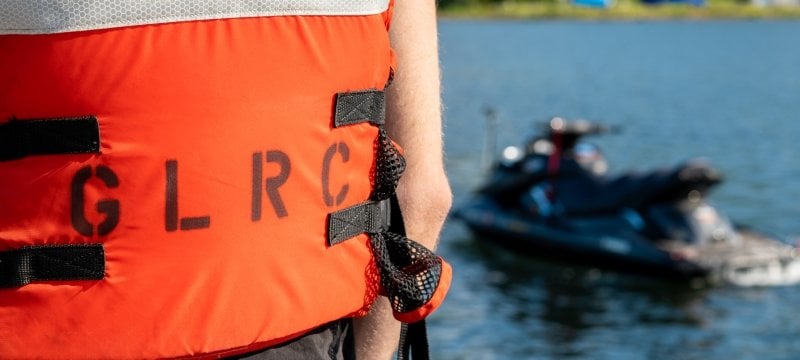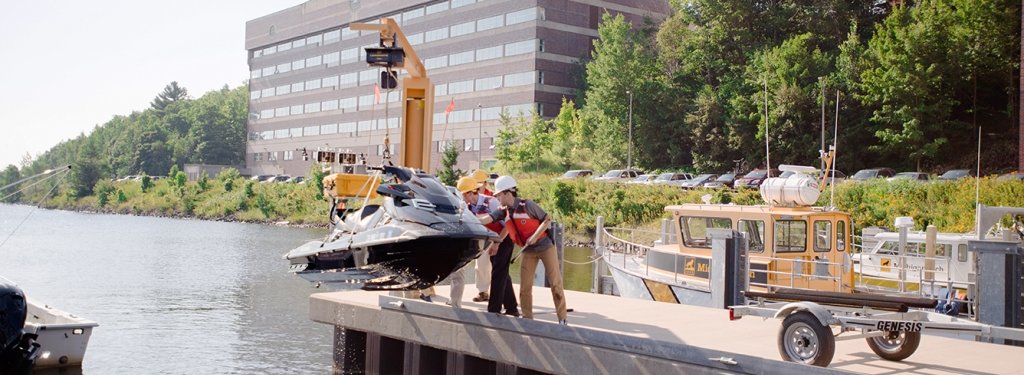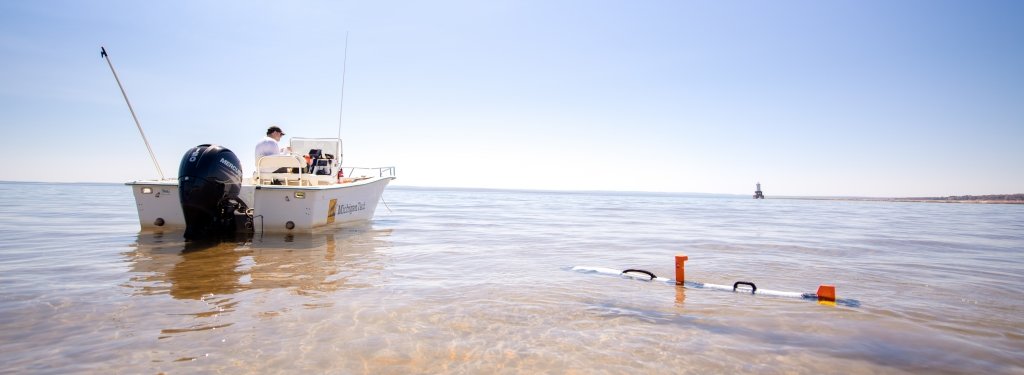The Smart Ships Coalition will gather at Michigan Technological University’s Great Lakes Research Center (GLRC) for a workshop Sept. 15-16. The Center, located on the campus waterfront, is home base for the Marine Autonomy Research Site (MARS), the first freshwater test bed of its kind in the world.
Technology is creating new ways to navigate waterways, but policy hasn’t kept pace. Experts from around the Great Lakes — and the world — are working together to address the uncharted territory of autonomous and intelligent maritime systems.

GLRC research engineer Travis White, who administers and coordinates coalition efforts, said 50 to 75 Smart Ships Coalition participants plan to attend the workshop. The event is an ideal opportunity to learn more about the coalition and the test site, or test bed, which is available to companies, research institutions, government agencies and others interested in surface and subsurface autonomous vehicles and related technologies. And, thanks to sponsorship by Michigan’s Office of the Great Lakes and Great Lakes Protection Fund, there’s no cost to participate.
Sign Up for the Smart Ships Workshop

The Sept. 15-16 workshop is for anyone interested in maritime mobility related to autonomy, artificial intelligence, computing, cybersystems, ethics, machine learning, policy, robotics, workforce development or related fields.
Registration for the workshop is open through Wednesday, Aug. 31.
“Panel and working group discussions are a big thrust of the workshop,” said White. “We want all the participants to be actively involved in addressing topics that are important to their interests and organizations.”
Automated and autonomous vessels and vessel technology aren’t on the horizon — they’re here. And they have a direct effect on world supply chain issues and the development of the new energy economy. Thinking through how smart technologies affect design, operations, safety, security, training and the workforce includes developing a regulatory framework.
“Autonomy is maybe one way we can move goods safely and more efficiently,” White said. “Everything we’re doing here is applicable on a national scale. We can move from pilotization to scale up. But technology is outpacing regulation. We can, as a coalition, take on this issue, helping industry work with government. At the workshop, coalition members will break into working groups to identify priority tasks and next steps to address.”
Vessels of Opportunity Launch from MTU’s Docks
The GLRC’s location on the Keweenaw Peninsula in Michigan’s Upper Peninsula is ideal for a test bed because of its access to diverse marine environments. The Keweenaw Waterway offers urban and industrial settings with a variety of depths in its mix of human-made narrows and natural lakes, bays and rivers. Lake Superior presents salt-, tide- and mammal-free deepwater sea conditions, complete with commercial shipping lanes and rugged undeveloped shorelines. The 30-mile radius of the test bed is clear of obstacles encountered on busier or more populated waters, such as manatee zones or heavy commercial and recreational traffic. “We can provide certain obstacles for test purposes,” said White. “We do so in a way that the interactions are more controlled and less random.”
“We welcome people who need a place to get their innovations in the water and experiment in a safe, controlled environment. We have the local knowledge and experience to help,” White added. The 2011 Tech alum holds a master 50-ton U.S. Coast Guard captain’s license and is a professional fishing guide deeply familiar with the mercurial moods of Superior. With assistance from the MTEC SmartZone, White put his knowledge and passion to use developing and marketing ProNav Marine, a smart GPS-guided autopilot system.
"This is the best place in the nation to test out this technology. We have a unique environment, accessibility and an abundance of supporting resources available at Michigan Tech."
1st
4
30-mile
50+
About the Great Lakes Research Center
As a coalition co-founder and test bed host, Michigan Tech’s Great Lakes Research Center rises to the challenge of being a leader in the development and exploration of autonomous and intelligent maritime systems. The process builds on achieving a reliable level of control — for example, operating the autonomous waverunner with multiple checks and balances, then adding more intelligent systems to the platform.

The GLRC’s potential research and development areas range from aquaculture and offshore renewable energy to maritime surveillance and shipping. White said the team’s current interests include wave dodging, which involves accurately reading and correctly reacting to the sea state on the Great Lakes in order to help ships navigate safely in rough waters. Thanks to a connected, ever-growing network of smart buoys, as well as the first high-frequency radar introduced to the Great Lakes, there is ample current data on wave height and direction to work with, said White. “As far as I know, no one’s really worked on wave-dodging to this extent.”
Researchers at GLRC, who often call the Keweenaw “the Arctic you can drive to,” are also exploring “winter hardening” of autonomous systems to increase durability for year-round use in Arctic-like environments.
"To develop autonomy right here in our backyard is ideal. We’re always willing to work with academic, government and industry partners."
The GLRC harnesses the interdisciplinary expertise of biologists, geologists, chemists, engineers, remote-sensing specialists and others to examine crucial issues in freshwater research. This includes modeling for better forecasts and climate predictions and assessing the spread of invasive species.
The GLRC accomplishes much of its work on, above and beneath Great Lakes waters utilizing the latest technologies. It’s home to the Superior Supercomputer, MARS and the Smart Ships Coalition, and MTU's fleet of surface and subsurface research vessels.
Other current projects include research in collaboration with the Mackinac Economic Alliance and Mackinac Marine Services that will reveal the potential for electrification of Mackinac Island ferries. The Center is also investigating the use of machine learning and artificial intelligence to automate detection and recognition of underwater targets, including shipwrecks.
Michigan Technological University is an R1 public research university founded in 1885 in Houghton, and is home to nearly 7,500 students from more than 60 countries around the world. Consistently ranked among the best universities in the country for return on investment, Michigan's flagship technological university offers more than 185 undergraduate and graduate degree programs in science and technology, engineering, computing, forestry, business, health professions, humanities, mathematics, social sciences, and the arts. The rural campus is situated just miles from Lake Superior in Michigan's Upper Peninsula, offering year-round opportunities for outdoor adventure.






Comments